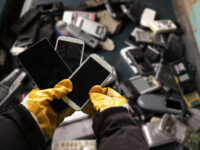
In summer of 2020, the United Nations released a report, “The Global E-Waste Monitor 2020,” highlighting how much electronic waste (e-waste) the world creates and where it goes. This report found that 53.6 million metric tons (Mt) of e-waste was generated in 2019, a growth of 9.2 Mt since 2014. That’s more than 59 million U.S. tons.
In addition to the high number for 2019, the report found e-waste is projected to grow to 74.7 Mt by 2030. While growth in electronic use continues, recycling has so far not kept up with the creation of e-waste. The world needs to recover more electronics to reuse their precious materials, such as gold, silver, copper, and platinum, as well as rare-earth elements. In fact, the 53.6 Mt of e-waste is equal to about $57 billion of high-value materials that were dumped or disappeared instead of being recycled and reused.
“By improving e-waste collection and recycling practices worldwide, a considerable amount of secondary raw materials — precious, critical, and non-critical — could be made readily available to re-enter the manufacturing process while reducing the continuous extraction of new materials,” the report said.
Of the 53.6 Mt created, only 17.4% was officially collected and recycled. That leaves 82.6% (44.3 Mt) unaccounted for — that’s a lot of trashed or improperly disposed electronics. Even broken or unusable e-waste can be recycled for materials or disposed of in a way that does not leak hazardous chemicals into our soil or waterways.
Did you know?
Source: The Global E-Waste Monitor 2020
• The U.S. generated about 7.6 million tons of e-waste in 2019.
• In 2017, only about 1.1 million tons of U.S. e-waste was recycled.
• On average, each American created 46 pounds of e-waste in 2019.
Even though many countries, such as the United States, have e-waste collection systems and regulations in place, the report reveals that we can do more to implement recycling efforts and ensure more of our electronics are properly collected and reused to keep harmful chemicals out of our environment and communities.
You can do your part by donating, reusing, or recycling your e-waste instead of throwing it away. Contact your local solid waste authority to learn about programs in your community. Here’s a link to the full report. For more, check out E-waste of space.
Photo Credit: baranozdemir | iStock | Getty Images Plus
